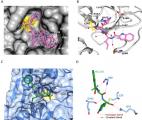Superconductors typically work only at extremely cold temperature – close to absolute zero. Researchers from Stanford University, SSRL and SIMES have been looking for superconductor materials that can perform at higher temperatures. Recently, the research team used photoemission measurements at SSRL beam line 5-4 to perform a detailed study on an electron-doped cuprate Nd2-xCexCuO4.
Approximately 1,700 scientists visit SSRL annually to conduct experiments in broad disciplines including life sciences, materials, environmental science, and accelerator physics. Science highlights featured here and in our monthly newsletter, Headlines, increase the visibility of user science as well as the important contribution of SSRL in facilitating basic and applied scientific research. Many of these scientific highlights have been included in reports to funding agencies and have been picked up by other media. Users are strongly encouraged to contact us when exciting results are about to be published. We can work with users and the SLAC Office of Communication to develop the story and to communicate user research findings to a much broader audience. Visit SSRL Publications for a list of the hundreds of SSRL-related scientific papers published annually. Contact us to add your most recent publications to this collection.
Celiac disease is an autoimmune disorder where the body's immune system attacks its own tissues when gluten is consumed. At the heart of this reaction is an enzyme called Transglutaminase 2 (TG2). TG2 helps modify gluten proteins in a way that makes them more likely to trigger this harmful immune response. This process depends on calcium, but until now, scientists had not fully understood how calcium interacts with TG2.
Topological flat bands in quantum materials represent a fascinating subject in condensed matter physics, often associated with numerous exotic phenomena, including superconductivity, magnetism, and charge density wave order. Flat bands are commonly found in quantum materials where the Coulomb interactions are comparable or larger than the electron kinetic energy. Searching for flat bands in real materials and uncovering the related intriguing phenomena as well as the underlying microscopic mechanisms are collectively referred to as flat band physics.
Olgotrelvir (STI-1558) is a novel antiviral drug designed to address the challenges posed by the emergence of new, more infectious and virulent SARS-CoV-2 variants. This drug is particularly important for populations at risk who may not benefit from existing treatments like Paxlovid due to potential drug-drug interactions. Olgotrelvir exhibits strong antiviral activity against the SARS-CoV-2 main protease (Mpro), including its variants which showed resistant to Paxlovid. Furthermore, it inhibits human cathepsin L (CTSL), a host enzyme critical for viral entry through the endosomal pathway, thereby blocking both the entry and replication of the virus. Phase 1 clinical trials have demonstrated that oral administration of Olgotrelvir achieves effective plasma levels with limited mild adverse effects and a promising reduction in viral RNA load.
High-resolution x-ray imaging can reveal chemical details in a number of fields including detection of metal contaminations in Si wafers; electrode dissolution and precipitation in lithium-ion batteries; and metal poisoning in catalytic materials for petroleum refinery – among others. However, using existing methods to balance resolution, sensitivity, and speed simultaneously has been challenging. A proposed new method integrates a full-field transmission x-ray microscope with an x-ray fluorescence detector to map at nanoscale without resorting to nanoscale x-ray focusing and raster scanning. This technique opens up opportunities across multiple fields by using x-rays to bridge the gap between structural and chemical characterizations.
In the Wood-Ljungdahl pathway (WLP), nature has devised one of the most elegant methods for the chemical transformation of carbon.1 The WLP is ancient, present in the last universal common ancestor to life on earth and is the only carbon fixation pathway known to produce more energy than is consumed in terms of net ATP. The WLP functions to scrub our atmosphere of the key greenhouse gas CO2, utilizing the carbon for energy and for the creation of cellular building material. This process occurs within the context of a large multi-unit protein complex made of carbon monoxide dehydrogenase (CODH) and acetyl-CoA synthase (ACS) in conjunction with a separate corrinoid iron-sulfur protein (CFeSP), which donates a methyl group to the ACS active site, resulting in the formation of acetate in the form of acetyl-CoA from the original CO2 molecule.
Designing customized proteins that have particular biological functions is of great interest to scientists working to develop disease therapies and diagnostics. While the functionality of proteins often involves physical shapes fitting together, the chemical qualities of the molecular surfaces make engineering these interactions complicated.
The omicron variant of COVID-19 was identified in the fall of 2021. It stood out from all of the other variants because of the many mutations that simultaneously occurred in its spike protein1. So far, surveillance and bioinformatics have been the main scientific tools in tracking COVID-19 evolution. Eventually, however, understanding COVID-19 evolution comes down to understanding the functions of key viral mutations. This is where structural biology kicks in and plays a critical role in tracking COVID-19 evolution.
Many practical catalysts, illustrated by those used for fossil fuel conversion and vehicle exhaust clean-up, consist of expensive noble metals dispersed on high-area porous solid supports. When the metals are atomically dispersed and isolated from each other, they offer new properties and the highest efficiency of metal use—with each metal atom accessible to reacting molecules. But applications of supported noble metal catalysts are usually limited by the loss of accessibility of reactants to the metals that results from metal aggregation (sintering) during operation. Sintering can be suppressed by anchoring the metal atoms strongly to metal oxide supports, but strong metal–oxygen interactions often leave too few metal sites available for reactant binding and catalysis.
Multiple sclerosis (MS) is a heterogeneous autoimmune disease in which autoreactive lymphocytes and antibodies attack the myelin sheath of the central nervous system (CNS). B lymphocytes in the cerebrospinal fluid (CSF) of MS patients contribute to inflammation and secrete oligoclonal immunoglobulins1,2. Epstein-Barr virus (EBV) infection has been linked to MS epidemiologically, but its pathological role remains unclear3,4.














